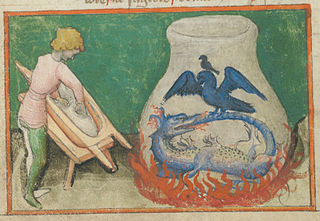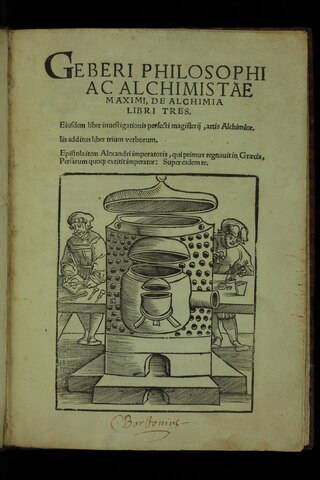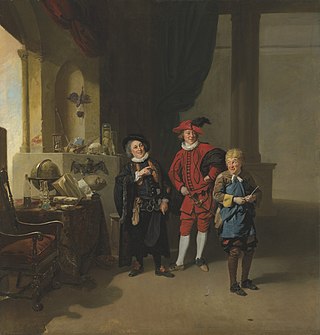Related Research Articles

Alchemy is an ancient branch of natural philosophy, a philosophical and protoscientific tradition that was historically practised in China, India, the Muslim world, and Europe. In its Western form, alchemy is first attested in a number of pseudepigraphical texts written in Greco-Roman Egypt during the first few centuries AD.

A grimoire is a textbook of magic, typically including instructions on how to create magical objects like talismans and amulets, how to perform magical spells, charms, and divination, and how to summon or invoke supernatural entities such as angels, spirits, deities, and demons. In many cases, the books themselves are believed to be imbued with magical powers, although in many cultures, other sacred texts that are not grimoires have been believed to have supernatural properties intrinsically. The only contents found in a grimoire would be information on spells, rituals, the preparation of magical tools, and lists of ingredients and their magical correspondences. In this manner, while all books on magic could be thought of as grimoires, not all magical books should be thought of as grimoires.
The occult, in the broadest sense, is a category of esoteric supernatural beliefs and practices which generally fall outside the scope of organized religion and science, encompassing phenomena involving otherworldly agency, such as magic and mysticism and their varied spells. It can also refer to supernatural ideas like extra-sensory perception and parapsychology. Literally, the term simply means "hidden", and is used in this sense in astronomy, for example when a star is "occulted" by the moon, i.e. passes from view as the moon moves in front of it. In the sense of parapsychology, the same Latin root indicates that the phenomenon is "hidden" from the physical, bodily senses.

Roger Bacon, also known by the scholastic accolade Doctor Mirabilis, was a medieval English philosopher and Franciscan friar who placed considerable emphasis on the study of nature through empiricism. In the early modern era, he was regarded as a wizard and particularly famed for the story of his mechanical or necromantic brazen head. He is sometimes credited as one of the earliest European advocates of the modern scientific method, along with his teacher Robert Grosseteste. Bacon applied the empirical method of Ibn al-Haytham (Alhazen) to observations in texts attributed to Aristotle. Bacon discovered the importance of empirical testing when the results he obtained were different from those that would have been predicted by Aristotle.

Hermeticism or Hermetism is a philosophical and religious system based on the purported teachings of Hermes Trismegistus. These teachings are contained in the various writings attributed to Hermes, which were produced over a period spanning many centuries and may be very different in content and scope.

Pseudo-Geber is the presumed author or group of authors responsible for a corpus of pseudepigraphic alchemical writings dating to the late 13th and early 14th centuries. These writings were falsely attributed to Jabir ibn Hayyan, an early alchemist of the Islamic Golden Age.

The so-called Emerald Tablet or Tabula Smaragdina is a one paragraph long Hermetic text. It was a highly regarded foundational text for many Islamic and European alchemists. Though attributed to the legendary Hellenistic figure Hermes Trismegistus, the text of the Emerald Tablet first appears in a number of early medieval Arabic sources, the oldest of which dates to the late eighth or early ninth century. It was translated into Latin several times in the twelfth and thirteenth centuries. Numerous interpretations and commentaries followed.

Picatrix is the Latin name used today for a 400-page book of magic and astrology originally written in Arabic under the title Ghāyat al-Ḥakīm, which most scholars assume was originally written in the middle of the 11th century, though an argument for composition in the first half of the 10th century has been made. The Arabic title translates as The Aim of the Sage or The Goal of The Wise. The Arabic work was translated into Spanish and then into Latin during the 13th century, at which time it got the Latin title Picatrix. The book's title Picatrix is also sometimes used to refer to the book's author.

Lynn Thorndike was an American historian of medieval science and alchemy. He was the son of a clergyman, Edward R. Thorndike, and the younger brother of Ashley Horace Thorndike, an American educator and expert on William Shakespeare, and Edward Lee Thorndike, known for being the father of modern educational psychology.
Alessio Piemontese, also known under his Latinized name of Alexius Pedemontanus, was the pseudonym of a 16th-century Italian physician, alchemist, and author of the immensely popular book, The Secrets of Alexis of Piedmont. His book was published in more than a hundred editions and was still being reprinted in the 1790s. The work was translated into Latin, German, English, Spanish, French, and Polish. The work unleashed a torrent of 'books of secrets' that continued to be published down through the eighteenth century.
George Starkey (1628–1665) was a Colonial American alchemist, medical practitioner, and writer of numerous commentaries and chemical treatises that were widely circulated in Western Europe and influenced prominent men of science, including Robert Boyle and Isaac Newton. After relocating from New England to London, England, in 1650, Starkey began writing under the pseudonym Eirenaeus Philalethes. Starkey remained in England and continued his career in medicine and alchemy until his death in the Great Plague of London in 1665.

Alchemy has had a long-standing relationship with art, seen both in alchemical texts and in mainstream entertainment. Literary alchemy appears throughout the history of English literature from Shakespeare to modern Fantasy authors. Here, characters or plot structure follow an alchemical magnum opus. In the fourteenth century, Chaucer began a trend of alchemical satire that can still be seen in recent fantasy works like those of Terry Pratchett.

Renaissance magic was a resurgence in Hermeticism and Neo-Platonic varieties of the magical arts which arose along with Renaissance humanism in the 15th and 16th centuries CE. During the Renaissance period, magic and occult practices underwent significant changes that reflected shifts in cultural, intellectual, and religious perspectives. C. S. Lewis, in his work on English literature, highlighted the transformation in how magic was perceived and portrayed. In medieval stories, magic had a fantastical and fairy-like quality, while in the Renaissance, it became more complex and tied to the idea of hidden knowledge that could be explored through books and rituals. This change is evident in the works of authors like Spenser, Marlowe, Chapman, and Shakespeare, who treated magic as a serious and potentially dangerous pursuit.
The Pfizer Award is awarded annually by the History of Science Society "in recognition of an outstanding book dealing with the history of science"
Historia animalium, published in Zurich in 1551–1558 and 1587, is an encyclopedic "inventory of renaissance zoology" by Conrad Gessner (1516–1565). Gessner was a medical doctor and professor at the Carolinum in Zürich, the precursor of the University of Zurich. The Historia animalium, after Aristotle's work of the same name, is the first modern zoological work that attempts to describe all the animals known, and the first bibliography of natural history writings. The five volumes of natural history of animals cover more than 4500 pages.
Isabella Cortese, was an Italian alchemist and writer of the Renaissance. All that is known of her life and work is from her book on alchemy, The Secrets of Lady Isabella Cortese. Cortese was also well-versed in several fields other than alchemy. She helped develop a variety of facial cosmetic products and made a variety of other contributions to science during the 16th century.

William R. Newman is Distinguished Professor and Ruth N. Halls Professor in the Department of History and Philosophy of Science at Indiana University. Most of Newman’s work in the History of Science has been devoted to alchemy and "chymistry," the art-nature debate, and matter theories, particularly atomism. Newman is also General Editor of the Chymistry of Isaac Newton, an online resource combining born-digital editions of Newton’s alchemical writings with multimedia replications of Newton’s alchemical experiments. In addition, he was Director of the Catapult Center for Digital Humanities and Computational Analysis of Texts at Indiana University. Newman is on the editorial boards of Archimedes, Early Science and Medicine, and HOPOS.
William Eamon is distinguished Achievement Professor, Regents Professor of History, and Dean of the Honors College at New Mexico State University. He is a specialist in the history of science and has published on various aspects of medieval and early modern science, medicine, and technology. His research focuses primarily on the history science and medicine in early modern Italy and Spain. His most influential work is on the history of the "books of secrets" tradition in medieval and early modern culture.
Von Stahel und Eysen is the first printed book on metallurgy, published in 1532 by several publishers: Kunegunde Hergot in Nuremberg, Melchior Sachs in Erfurt, and Peter Jordan in Mainz. It has been suggested that Hergot was probably the first to publish the text, as the material seems to come from Nuremberg: its material on tempering and quenching is similar to the short treatise on hardening iron beginning 'Von dem herten. Nu spricht meister Alkaym' in the late fourteenth- or early fifteenth-century Nuremberg manuscript Nürnberger Handschrift GNM 3227a.

The Grand Albert is a grimoire that has often been attributed to Albertus Magnus. Begun perhaps around 1245, it received its definitive form in Latin around 1493, a French translation in 1500, and its most expansive and well-known French edition in 1703. Its original Latin title, Liber secretorum Alberti Magni de virtutibus herbarum, lapidum et animalium quorumdam, translates to English as "the book of secrets of Albert the Great on the virtues of herbs, stones and certain animals". It is also known under the names of The Secrets of Albert, Secreta Alberti, and Experimenta Alberti.
References
- ↑ W. Eamon, Science and the Secrets of Nature: Books of Secrets in Medieval and Early Modern Culture (Princeton: Princeton University Press, 1994).